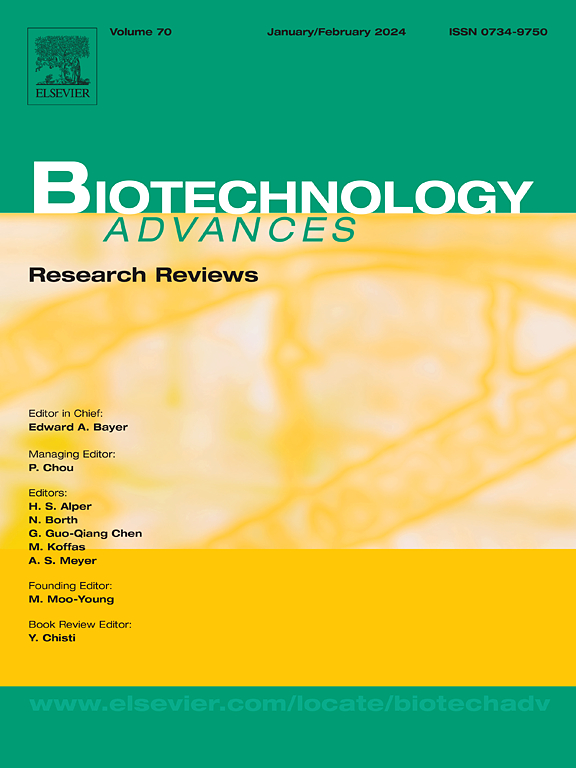Marine fungal enzymes as potential degraders of the diverse seaweed cell-walls
IF 12.5
1区 工程技术
Q1 BIOTECHNOLOGY & APPLIED MICROBIOLOGY
引用次数: 0
Abstract
Marine fungi play a critical yet understudied role in marine ecosystems, contributing to microbial diversity and ecological balance through their interactions with seaweed and other organisms. These interactions are essential for nutrient cycling and maintaining ecosystem health. While the carbohydrate-active enzymes (CAZymes) of terrestrial fungi are well-documented for plant biomass degradation, the enzymatic capabilities of marine fungi, specifically for degrading seaweed biomass, remain less explored. The distinct sugar composition of seaweed has likely shaped the CAZome of marine fungi, specifically in activities targeting seaweed cell wall polysaccharides. This review focuses on the potential of marine fungal CAZymes as biocatalysts for the degradation of seaweed cell wall polysaccharides. We provide a detailed examination of the unique sugar composition of seaweed cell walls, such as alginates, fucoidans, and carrageenans, and analyze the putative CAZy abilities of marine fungi to target these structures. A better understanding of marine fungal enzymatic processes could unlock sustainable strategies for extracting valuable compounds, such as proteins and nutraceuticals, from seaweed biomass, while enabling the comprehensive valorization of all biomass fractions within a biorefinery framework. By summarizing current knowledge and identifying research gaps, this review highlights the untapped potential of marine fungi as key agents in the development of efficient, integrated seaweed biorefineries.
海洋真菌酶作为各种海藻细胞壁的潜在降解剂。
海洋真菌在海洋生态系统中发挥着至关重要但尚未得到充分研究的作用,通过与海藻和其他生物的相互作用,促进微生物多样性和生态平衡。这些相互作用对养分循环和维持生态系统健康至关重要。虽然陆生真菌的碳水化合物活性酶(CAZymes)对植物生物量的降解有充分的记载,但海洋真菌的酶活性,特别是对海藻生物量的降解能力,仍然很少被探索。海藻独特的糖组成可能塑造了海洋真菌的CAZome,特别是针对海藻细胞壁多糖的活动。本文综述了海洋真菌酶作为海藻细胞壁多糖降解生物催化剂的潜力。我们详细研究了海藻细胞壁的独特糖组成,如海藻酸盐、岩藻酸胶和卡拉胶,并分析了海洋真菌针对这些结构的推测的CAZy能力。更好地了解海洋真菌酶促过程可以为从海藻生物质中提取有价值的化合物(如蛋白质和营养品)提供可持续的策略,同时在生物炼制框架内实现所有生物质馏分的全面增值。通过总结目前的知识和确定研究空白,本综述强调了海洋真菌作为开发高效、综合海藻生物炼制的关键因素的未开发潜力。
本文章由计算机程序翻译,如有差异,请以英文原文为准。
求助全文
约1分钟内获得全文
求助全文
来源期刊

Biotechnology advances
工程技术-生物工程与应用微生物
CiteScore
25.50
自引率
2.50%
发文量
167
审稿时长
37 days
期刊介绍:
Biotechnology Advances is a comprehensive review journal that covers all aspects of the multidisciplinary field of biotechnology. The journal focuses on biotechnology principles and their applications in various industries, agriculture, medicine, environmental concerns, and regulatory issues. It publishes authoritative articles that highlight current developments and future trends in the field of biotechnology. The journal invites submissions of manuscripts that are relevant and appropriate. It targets a wide audience, including scientists, engineers, students, instructors, researchers, practitioners, managers, governments, and other stakeholders in the field. Additionally, special issues are published based on selected presentations from recent relevant conferences in collaboration with the organizations hosting those conferences.
 求助内容:
求助内容: 应助结果提醒方式:
应助结果提醒方式:


